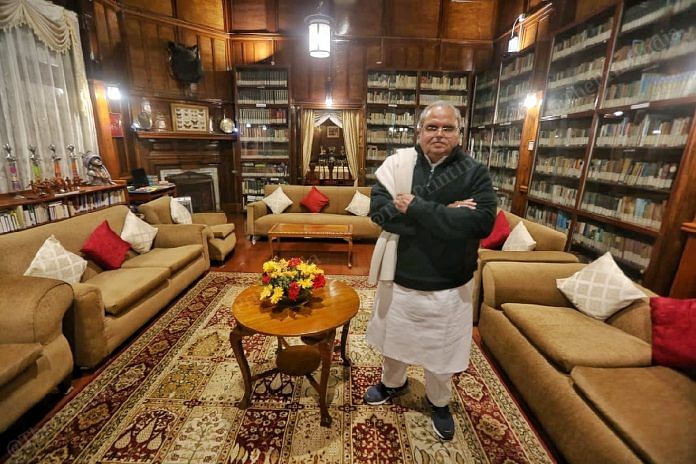Shillong: Meghalaya Governor Satya Pal Malik has said that implementing the Inner-Line Permit (ILP) will affect investment and tourism in the state, even as he informed ThePrint that he had pleaded with the Centre for ILP during his recent visit to New Delhi.
The ILP is an official travel document that allows an Indian citizen into a protected area for a limited period.
Stating he has no objection to the travel document if it is for protection of the locals, Malik Friday told a section of the local media in Shillong that it will hurt the state’s interests.
“I have not understood how ILP will help people in Meghalaya. You will have no investment, no tourism, nobody will come to you, and ultimately it will be harmful,” he said. ““This is not my opinion, but assessment. Whether or not ILP should be implemented is the Centre’s prerogative.”
He added that the ILP would not be essential if the Meghalaya Residents Safety and Security Act (MRSSA) is implemented.
Pressure groups in the state have been vociferously demanding implementation of the ILP ever since the Congress-led government rejected the demand in 2013 and instead passed the MRSSA in 2016.
The MRSSA is considered to be part of a “comprehensive mechanism” to check illegal immigration – with its focal point on tenants. In March, the Meghalaya assembly passed the Meghalaya Residents Safety and Security (Amendment) Bill (MRSSAB), 2020 to regulate the entry of outsiders and tenants in the state.
Also read: Another year, another mining tragedy — why Meghalaya’s ‘rat holes’ won’t stop killing
Awaiting Governor’s nod
The amendment bill has since been pending before the Governor. The new law states every person who intends to stay in Meghalaya for more than 48 hours shall furnish information in the manner prescribed under the rules.
“If MRSSA is passed, then ILP is not required at all,” the Governor said, pointing out that an Act like MRSAA cannot be implemented without the support of the Centre.
As pressure groups resumed their agitation demanding ILP implementation last year, the Meghalaya Assembly had on 18 December, 2019, unanimously adopted a resolution urging the Centre to implement ILP in the state. The resolution was moved by Chief Minister Conrad K. Sangma with support from all members across party lines including the BJP.
Earlier last year, Governor Satya Pal Malik assured to take up the demand for immediate implementation of ILP during his visit to Delhi. He was recently on a three-day visit to Delhi on 28 January.
The civil society organisations from the Khasi, Jaintia and the Garo Hills of Meghalaya under the Confederation of Meghalaya Social Organisations (CoMSO) and other groups want the ILP to be made applicable in their state without delay, especially after the Centre approved the Citizenship Act in 2019.
Also read: Why PM Modi referred to Assam’s ‘mool niwasi’ 7 times in his speech but skipped CAA
Why Meghalaya wants ILP?
There has been a fear among the indigenous people of Northeast against illegal immigration, its effects and long-term damages. Northeast India shares borders with countries such as China, Myanmar, Bangladesh and Bhutan.
It is the fear of indigenous people losing their land, identity and future that has led them to search for possible solutions to the problem. Meghalaya shares a 443-km border with Bangladesh.
“There is a genuine apprehension that the CAA will have a fallout that will unfold over a period of time affecting the demography of the state,” former chief minister and leader of the opposition Congress, Mukul Sangma, told ThePrint. “Besides, the government of India promptly agreeing to implement ILP in some states and not others has also triggered the demand in Meghalaya.”
‘Increased influx noticed’
Speaking to ThePrint, Khasi Students’ Union (KSU), an influential students’ body in Meghalaya said the demand for ILP implementation started way back in 1979 and it is needed “to safeguard the identity, language, culture of the indigenous communities”.
“There might be different views regarding implementation of ILP, but we are very much concerned with the influx issue in Meghalaya — from the environment around, we notice that illegal immigration has increased,” KSU chief Lambok Marngar said. “Without strong mechanisms, it is very dangerous for us, especially we are a minority and a microscopic community in the state of Meghalaya and across the country.”
“People can say it will affect tourism or development, but that is to mislead us. Are tourists not visiting other states under the ILP system?” he asked. “The ILP is not to block tourism or development but we need people to enter our state with a proper document. If the Centre can grant ILP to Manipur, they must do the same for Meghalaya.”
The ILP already exists in Nagaland, Mizoram and Arunachal Pradesh, and came into effect in Manipur from 1 January, making it the fourth northeastern state to come under ILP regime. Outsiders visiting these states need to carry this travel document.
Also read: 2 Manipur editors, ‘author’ booked under sedition law, UAPA for ‘endorsing armed revolution’



